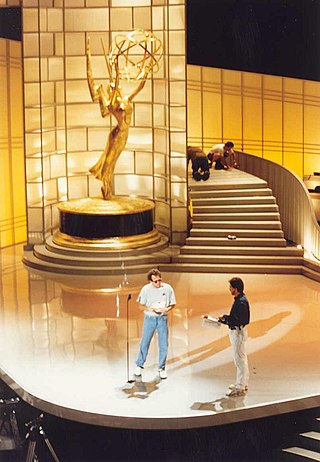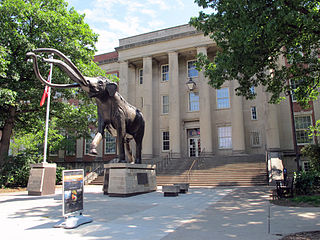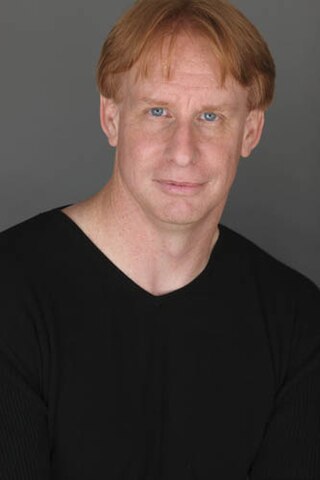Related Research Articles

The Emmy Awards, or Emmys, are an extensive range of awards for artistic and technical merit for the American and international television industry. A number of annual Emmy Award ceremonies are held throughout the calendar year, each with their own set of rules and award categories. The two events that receive the most media coverage are the Primetime Emmy Awards and the Daytime Emmy Awards, which recognize outstanding work in American primetime and daytime entertainment programming, respectively. Other notable U.S. national Emmy events include the Children's & Family Emmy Awards for children's and family-oriented television programming, the Sports Emmy Awards for sports programming, News & Documentary Emmy Awards for news and documentary shows, and the Technology & Engineering Emmy Awards and the Primetime Engineering Emmy Awards for technological and engineering achievements. Regional Emmy Awards are also presented throughout the country at various times through the year, recognizing excellence in local and statewide television. In addition, the International Emmy Awards honor excellence in TV programming produced and initially aired outside the United States.

A laser lighting display or laser light show involves the use of laser light to entertain an audience. A laser light show may consist only of projected laser beams set to music, or may accompany another form of entertainment, typically musical performances.

Griffith Observatory is an observatory in Los Angeles, California, on the south-facing slope of Mount Hollywood in Griffith Park. It commands a view of the Los Angeles Basin including Downtown Los Angeles to the southeast, Hollywood to the south, and the Pacific Ocean to the southwest. The observatory is a popular tourist attraction with a close view of the Hollywood Sign and an extensive array of space and science-related displays. It is named after its benefactor, Griffith J. Griffith. Admission has been free since the observatory's opening in 1935, in accordance with the benefactor's will.

The University of Nebraska State Museum, also known as Morrill Hall, founded in 1871, is a natural history museum featuring Nebraska biodiversity, paleontology, and cultural diversity, located on the University of Nebraska–Lincoln City Campus near the corner of 14th and Vine Streets in Lincoln, Nebraska, United States. The museum houses Mueller Planetarium, a hands-on science discovery center, and the Elephant Hall, where visitors can see the world's largest articulated fossil mammoth among the collection of fossil elephants. Also featured are interactive paleontology exhibits, a dinosaur gallery, ancient life and evolution exhibits, wildlife dioramas, gems and minerals, American Indian and African exhibits, and a temporary exhibit gallery featuring rotating displays on diverse topics including photography, quilts and fine arts.
Suzanna Celeste de Passe(sources differ) is an American businesswoman, television, music and film producer. De Passe serves as the co-chairwoman of de Passe Jones Entertainment Group.

The London Planetarium building is located on Marylebone Road, London. It is adjacent to and owned by Madame Tussauds. It previously housed a planetarium, offering shows related to space and astronomy. In 2006, it was closed as a separate attraction and became part of Madame Tussauds. Since 2010, the building that previously housed the London Planetarium has been home to the Marvel Super Heroes 4D attraction.

Manick Sorcar is an Indian American artist, animator, engineer, and laserist. Sorcar is an artist in various media, including fine arts, cartoons, animations, laser arts, and world-touring stage shows with live action mixed with laser animation. His animated films, all based on children's stories from India, have won prestigious awards at international film festivals and been broadcast on the Public Broadcasting Service for 25 consecutive years. His laser arts and animation in various forms have won global awards from the International Laser Display Association.
The International Laser Display Association (ILDA) is the worldwide non-profit trade association and is dedicated to advancing the use of laser displays in art, entertainment and education. It was founded in August 1986. ILDA sponsors an annual conference and the annual ILDA Awards for artistic and technical achievement in laser shows and displays.

Telus World of Science Edmonton (TWOSE) is a broad-based science centre in Edmonton, Alberta, Canada, operated by the (non-profit) Edmonton Space & Science Foundation. The centre is located on the southwest corner of Coronation Park in the neighborhood of Woodcroft. The science centre houses 144,430 sq. ft. of public space and is the largest science centre in Western Canada. It is currently a member of both the Association of Science-Technology Centers (ASTC) and the Canadian Association of Science Centres (CASC).

The Themed Entertainment Association (TEA) is an international non-profit association that represents creators, developers, designers and producers of themed entertainment. It is also noted for its THEA Awards, which were founded in 1995 and are distributed annually in a range of themed entertainment categories.
Jordan Belson was an American artist and abstract cinematic filmmaker who created nonobjective, often spiritually oriented, abstract films spanning six decades.
Swamiji is a 2012 laser show and documentary film directed and produced by Manick Sorcar. Based on the life story of Hindu monk Swami Vivekananda (1863–1902), it is the first laser documentary made on an individual and the first full-length laser documentary ever to be shown in a performing arts center.
The Molecularium Project is an informal science education project of Rensselaer Polytechnic Institute. The Project introduces young audiences to the world of atoms and molecules using character driven stories, immersive animation, interactive games and activities, and state of the art molecular visualizations. Rensselaer's three principal scientist and educators behind the project are Linda Schadler, Richard W. Siegel, and Shekhar Garde. The Molecularium Project began as an outreach project of Rensselaer's Nanoscale Science and Engineering Center. To realize the productions, the scientists employed the creative team Nanotoon Entertainment, led by writer and director V. Owen Bush, and writer/producer Kurt Przybilla. The Molecularium Project is funded by Rensselaer, the National Science Foundation, and New York State.
Fulldome refers to immersive dome-based video display environments. The dome, horizontal or tilted, is filled with real-time (interactive) or pre-rendered (linear) computer animations, live capture images, or composited environments.

The Phillip and Patricia Frost Museum of Science is a science museum, planetarium, and aquarium located in Miami, Florida, United States. The museum originally opened its Coconut Grove location across from Vizcaya Museum and Gardens in 1960. It relocated to Museum Park in the downtown area adjacent to the Perez Art Museum Miami in 2017 after the closing of the Coconut Grove location in 2015.

The Museum of Science & History (MOSH) is a museum in Jacksonville, Florida. It is a private, non-profit institution located on the Southbank Riverwalk, and the city's most visited museum. It specializes in science and local history exhibits. It features a large traveling exhibit that changes quarterly, three floors of permanent and signature exhibits, and the Bryan-Gooding Planetarium.
Bryan-Gooding Planetarium in the Alexander Brest Science Theatre is a planetarium in the Museum of Science and History in Jacksonville, Florida, U.S. It was built in 1988 and featured a 60-foot-diameter (18 m) dome-shaped projection screen, JBL stereo sound system, and a Zeiss Jena Optical mechanical planetarium star projector. The facility has seating for 200, and approximately 60,000 people see a planetarium show each year.
Elsa M. Garmire, Elsa Meints Garmire, was born in Buffalo, New York, on November 9, 1939. She is the Sydney E. Junkins Professor of Engineering at Dartmouth College, where she has served as Dean of Thayer School of Engineering. Elected to the American Academy of Arts and Sciences, the National Academy of Engineers, and the National Academy of Inventors, she helped pioneer laser technology and is an expert in nonlinear optics. She has patented devices to enhance optical communications including lasers, waveguides, and detectors.

Kevin R. Grazier is an American planetary physicist, known for his work on the Cassini/Huygens Mission to Saturn and Titan where he had the dual roles of Science Planning Engineer and Investigation Scientist for the Imaging Science Subsystem instrument. He is an expert in computational methods and planetary dynamics and performs large-scale, long-term simulations of early Solar System evolution, dynamics, and chaos.
References
- George, Jason (2005-02-05). "A 70's Duo Rocks On: Pink Floyd and Lasers". New York Times. Retrieved 2017-05-30.
- Ehrman, Mark (2002-01-09). "The Night the Lights Went Out in Griffith Park". Los Angeles Times. Retrieved 2017-05-30.
- Ira Flatow (2016-04-22). "When Laser Science Was 'Far Out'". Science Friday (Podcast). Science Friday Initiative. Retrieved 2017-05-30.
- McCray, Patrick (2016-04-22). "From Laser Art to Laserium". Leaping Robot Blog. Retrieved 2017-05-30.
- Harlander, Thomas (2016-08-25). "L.A.'s Forgotten Laser Emporium Will Take You Back to the '70s". Los Angeles Magazine. Retrieved 2017-05-30.
- "Legacies: Marty Sklar, Ivan Dryer, Ira West, George Casey". inpark Magazine. 2017-08-02. Retrieved 2017-08-03.
- "Ivan Dryer, Laserium Founder and Laser Show Pioneer, Dies At 78". LiveDesign Magazine. 2017-08-02. Retrieved 2017-08-03.
- Specific
- ↑ Epstein, Sonia (10 July 2018). "Creatures of Light: Laserium". Sloan Science & Film.
- ↑ LaserImage film at YouTube
- ↑ From an image in a 1975 Laserium program, listing sites of "Continuous, ongoing concerts"
- ↑ ILDA Career Achievement Award recipients (click on 1989 entry)
- ↑ List of ILDA Award winners, 1988-2014 (download spreadsheet)
- ↑ ILDA Board timeline
- ↑ ILDA history and timeline
- ↑ March 7 - International Laserist Day